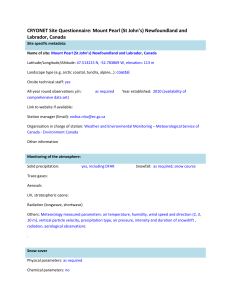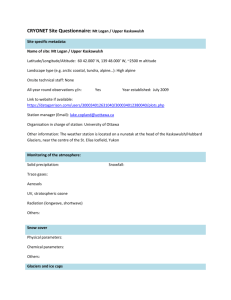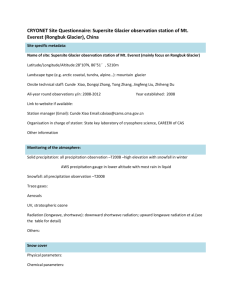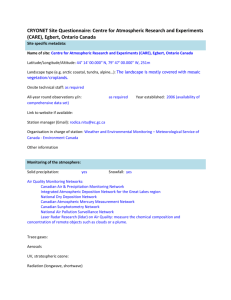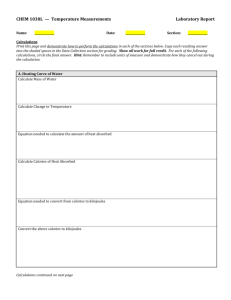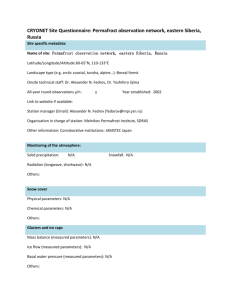Chapter 3
advertisement
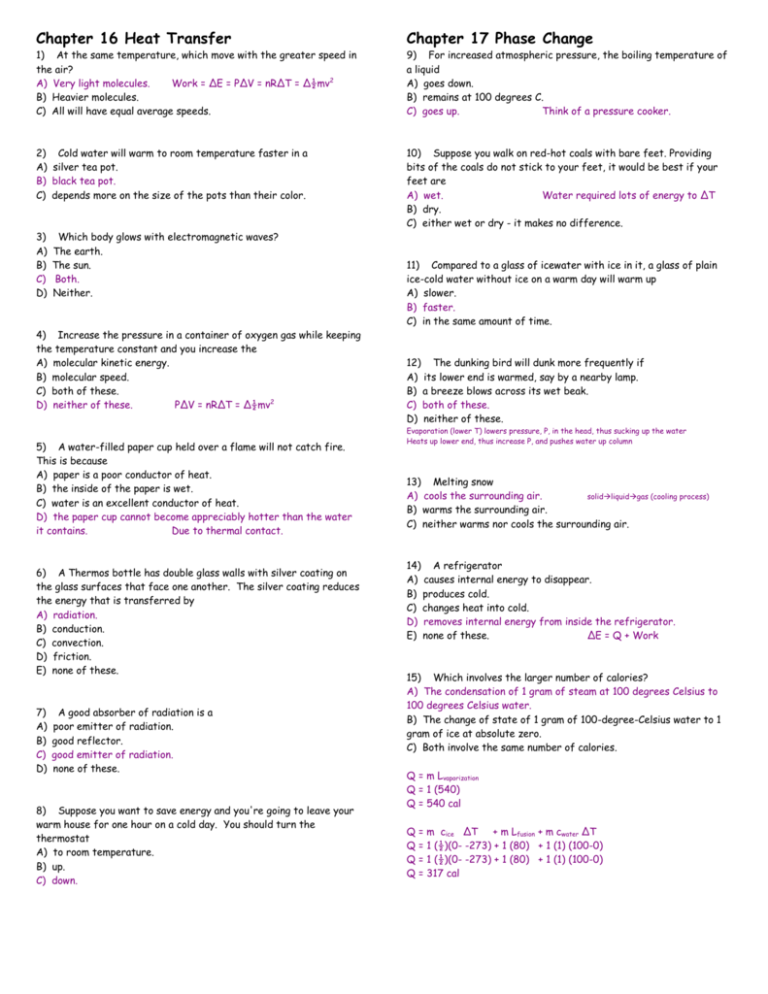
Chapter 16 Heat Transfer Chapter 17 Phase Change 2) Cold water will warm to room temperature faster in a A) silver tea pot. B) black tea pot. C) depends more on the size of the pots than their color. 10) Suppose you walk on red-hot coals with bare feet. Providing bits of the coals do not stick to your feet, it would be best if your feet are A) wet. Water required lots of energy to ΔT B) dry. C) either wet or dry - it makes no difference. 1) At the same temperature, which move with the greater speed in the air? A) Very light molecules. Work = ΔE = PΔV = nRΔT = Δ½mv2 B) Heavier molecules. C) All will have equal average speeds. 3) A) B) C) D) Which body glows with electromagnetic waves? The earth. The sun. Both. Neither. 4) Increase the pressure in a container of oxygen gas while keeping the temperature constant and you increase the A) molecular kinetic energy. B) molecular speed. C) both of these. D) neither of these. PΔV = nRΔT = Δ½mv2 5) A water-filled paper cup held over a flame will not catch fire. This is because A) paper is a poor conductor of heat. B) the inside of the paper is wet. C) water is an excellent conductor of heat. D) the paper cup cannot become appreciably hotter than the water it contains. Due to thermal contact. 6) A Thermos bottle has double glass walls with silver coating on the glass surfaces that face one another. The silver coating reduces the energy that is transferred by A) radiation. B) conduction. C) convection. D) friction. E) none of these. 7) A) B) C) D) A good absorber of radiation is a poor emitter of radiation. good reflector. good emitter of radiation. none of these. 8) Suppose you want to save energy and you're going to leave your warm house for one hour on a cold day. You should turn the thermostat A) to room temperature. B) up. C) down. 9) For increased atmospheric pressure, the boiling temperature of a liquid A) goes down. B) remains at 100 degrees C. C) goes up. Think of a pressure cooker. 11) Compared to a glass of icewater with ice in it, a glass of plain ice-cold water without ice on a warm day will warm up A) slower. B) faster. C) in the same amount of time. 12) The dunking bird will dunk more frequently if A) its lower end is warmed, say by a nearby lamp. B) a breeze blows across its wet beak. C) both of these. D) neither of these. Evaporation (lower T) lowers pressure, P, in the head, thus sucking up the water Heats up lower end, thus increase P, and pushes water up column 13) Melting snow A) cools the surrounding air. solidliquidgas (cooling process) B) warms the surrounding air. C) neither warms nor cools the surrounding air. 14) A refrigerator A) causes internal energy to disappear. B) produces cold. C) changes heat into cold. D) removes internal energy from inside the refrigerator. E) none of these. ΔE = Q + Work 15) Which involves the larger number of calories? A) The condensation of 1 gram of steam at 100 degrees Celsius to 100 degrees Celsius water. B) The change of state of 1 gram of 100-degree-Celsius water to 1 gram of ice at absolute zero. C) Both involve the same number of calories. Q = m Lvaporization Q = 1 (540) Q = 540 cal Q Q Q Q = m cice ΔT + m Lfusion + m cwater ΔT = 1 (½)(0- -273) + 1 (80) + 1 (1) (100-0) = 1 (½)(0- -273) + 1 (80) + 1 (1) (100-0) = 317 cal Chapter 16 Heat Transfer 1) The higher the temperature of an object, the A) shorter the wavelengths it radiates. B) longer the wavelengths it radiates. 2) An object will normally be a net radiator of energy when its temperature is A) lower than its surroundings. B) higher than its surroundings. C) neither of these. 3) A) B) C) D) The planet Earth loses heat mainly by conduction. radiation. convection. all of these. 4) If air were a better conductor than it is, at nighttime the earth would be A) not appreciably different in temperature. B) considerably warmer. C) considerably colder. 5) Both black and white road surfaces radiate energy. At the end of a starry night (no clouds) the warmer road surface will be A) the white surface. B) the black surface. C) neither -- there is no difference. 6) When a volume of air is compressed, its temperature A) neither increases nor decreases. B) increases. Only way to compress is to do work on it, thus raise Eint C) decreases. 7) A) B) C) D) A good reflector of radiation is poor absorber of radiation. good emitter of radiation. good absorber of radiation. none of these. 8) Suppose you want to save energy and you're going to leave your cool house for an hour on a hot day. You should turn the temperature setting on the air conditioner A) up a little. B) off altogether. C) down a little. D) to room temperature. Chapter 17 Phase Change 9) In the mountains, water in an open pot boils at A) a higher temperature than at sea level. B) the same temperature as at sea level. C) a lower temperature than at sea level. 10) To turn ice at 0 °C to water at 0 °C, we must add A) temperature. B) force. C) time. D) energy. E) it can't be done -- water is always warmer than that. 11) To turn 50 grams of boiling water to steam requires A) 50 calories. B) 500 calories C) 540 calories. D) more calories than are required to bring 50 grams of ice at absolute zero to the boiling point. Q = mL = 50g (540 cal/g) E) none of these. 12) Food in a pressure cooker is cooked faster because of the A) greater rate of bubble formation in the water. B) higher temperature. C) increased internal energy in the water. D) all of these. E) none of these. 13) When water vapor condenses on the inside of a window, the room becomes slightly A) warmer. B) neither warmer nor cooler. C) cooler. 14) Ice is put in a cooler in order to cool the contents. In order to speed up the cooling process, the ice can be A) wrapped in newspaper. B) crushed. C) drained of ice water periodically. D) kept in circulating air currents provided by a small fire under one end of the cooler. E) kept out of contact with the food. 15) Stored potatoes, beets, and rutabagas freeze at temperatures below zero degrees Celsius (rather than AT zero) because A) The water in them contains dissolved salts and sugars. B) They are good radiators of energy. C) They are good absorbers of radiant energy. D) They are very dense. E) All of these.


